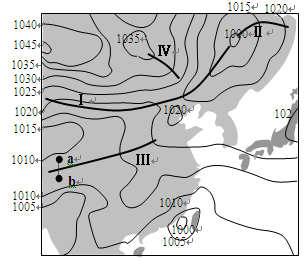问题
选择题
读亚洲东部10月23日某时海平面等压线分布图,完成问题。

小题1:图中所画锋线错误的是
A.Ⅰ、Ⅲ
B.Ⅰ、Ⅱ
C.Ⅱ、Ⅲ
D.Ⅲ、Ⅳ小题2:引起此时我国北方与华南沿海均出现大风天气的天气系统,分别是
A.蒙古西伯利亚高压,印度低压
B.冷锋,强热带风暴
C.亚洲高压,暖锋
D.冷锋、亚洲低压小题3:下列示意图能正确反映Ⅲ附近a、b两地间的气压分布状况是

A B C D
答案
小题1:D
小题2:B
小题3:C
本题考查等压线天气图的综合判断。
小题1:图示Ⅲ、Ⅳ为高压脊,故不可能出现锋面。
小题2:结合图示我国北方受蒙古西伯利亚高压的前锋—冷锋影响而出现大风天气,而我国华南沿海受气旋影响,即热带风暴影响,而出现大风天气。
小题2:根据Ⅲ线穿过的两条等压线数值1020和1015,图判断图示Ⅲ为高压脊,故ab之间气压较高,而图示a更接近1010等压线,表示气压较低。
